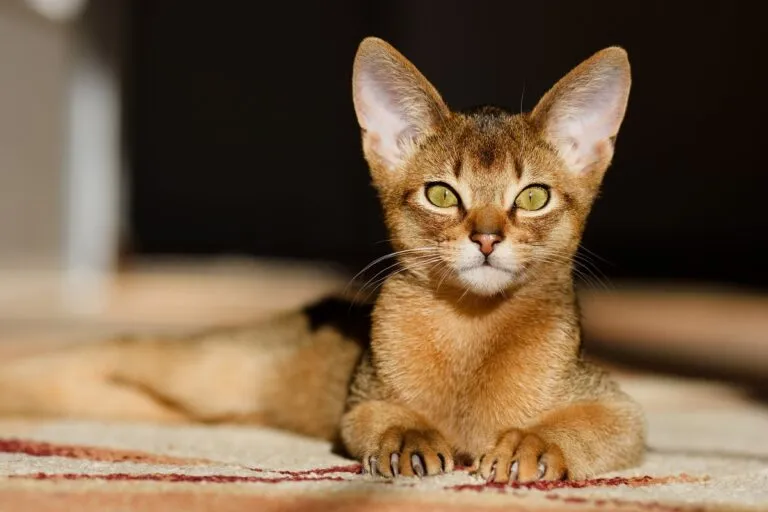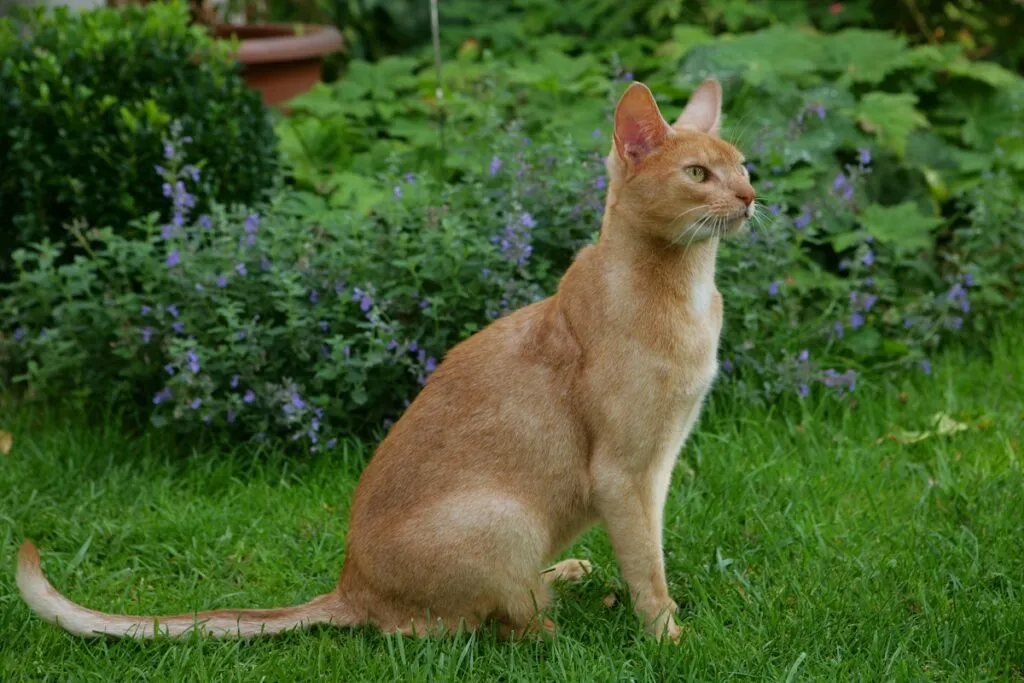Maine Coon
The Maine Coon has now become one of the most popular cat breeds in the world and is enjoying increasing popularity in Ireland, too. This is probably thanks to its authenticity, robustness and excellent character.
Large eyes and attentively upright ears instantly tell you a great deal about this charming breed of cat: Abyssinians are inquisitive and affectionate towards people.

© Anobis / stock.adobe.com
The Abyssinian cat is often described as a miniature puma. No wonder, given its slim, long-legged body and athletic, lively character! The Abyssinian is a particularly light cat breed, with females weighing just 4kg and males up to 5kg.
The open-minded, curious nature of these animals is reflected clearly in their faces. Their large, almond-shaped eyes shine in shades of amber, green or light brown. Particularly striking is the dark border surrounding these gleaming eyes. The large ears show that these cats are great listeners that are always utterly absorbed in their environment. They are very interested in the lives their humans lead! These ears are placed far apart and have a broad base. The Abyssinian’s head itself is wedge-shaped, contouring gently down into the slender, graceful feline neck. Long legs end in oval-shaped paws and a slim tail completes the image of an active, agile cat.
An Abyssinian’s fur is extremely fine and soft, thanks to its low quantity of undercoat. Although the fur around their shoulders is shorter still, they have a well-developed ruff of hair around their neck.
Abyssinians have particularly striking colouring, with their fur resembling that of a wild rabbit. This so-called “agouti effect” is characterised by different bands of colour wrapping around each individual hair. This gives a unique “ticking” pattern. Each hair contains between two and four bands of colour, with the tip of the hair carrying the darkest shade. This ticking is not present in all of the body hair, but primarily around the head, back, tail and outside of the legs. The stomach, chest and inside of the legs show the uniform base colour of the cat.
“Ticking” is a vital part of the Abyssinian breeding standards. The colouring begins to appear during the sixth week of life. However, it can take up to two years for it to be fully developed into a uniformly-patterned coat resembling that of a wild hare.
An Abyssinian’s colours are unique. The most common colourings found in breeding are blue, sorrel, fawn and usual.
Other colourings such as chocolate and its diluted form lilac do appear, but are not currently recognised by all breeders.
Long-haired varieties of the Abyssinian have been appearing in primarily English litters since the 1950s. These cats became a breed in their own right, known as the Somali cat. The Abyssinian and the Somali share a breed standard as, apart from their fur length, they are practically identical.
 © absolutimages / stock.adobe.com
© absolutimages / stock.adobe.com
The Abyssinian is an oriental cat through and through. It is attentive, playful and active. It will curiously follow its owners around, watching every move. Abyssinians are also considered to be extremely intelligent and respond well to encouragement and praise. Feeding games, clicker training and even small tricks can all be of great interest to the inquisitive Abyssinian! This is particularly true when it comes to games played with people.
Abyssinians are very social animals and will completely devote themselves to their human family, only reluctantly staying on their own. However, a fellow feline companion is the only thing that can truly make this cat breed happy. This is why they are ideally not kept as the sole cat in a household. When living with other cats, you will find the Abyssinian is a more dominant creature. This is why socialising it from a young age can be extremely beneficial. Many people find that a sibling pair from a litter make a great team. If you have the space and time for a pair of kittens, your Abyssinian will thank you!
The Abyssinian is a very active breed of cat and will ideally not be kept solely indoors. Secure gardens or cat balconies can offer a wealth of opportunities for climbing and moving around, meeting instinctive feline needs.
The name “Abyssinian” is not only misleading, it is in fact incorrect. This breed of cat does not come from the land it is named after, “Abyssinia”, modern-day Ethiopia. A claim that Abyssinian cats are the descendants of those worshipped by the Pharaohs in Ancient Egypt is also wrong. The Abyssinian cat actually comes from an entirely different area, namely from the South East Asian jungle. This revelation came from the wonder of modern genetics. It was discovered that this breed of cat contains a mutation of the tabby genes that has never been found in Egyptian or East African cats. However, wild cats from areas along the coast of the Indian Ocean somewhere between Singapore and Sri Lanka were found to display this striking mutation. This caused the colouring seen in Abyssinians today.
There are further references to these cats made in pictures from the 19th century, namely in an English cat journal in which it was described as an “Asiatic cat”. It is assumed that these stunning “ticked” cats were brought to the Near East and Africa by British handlers, and then brought to England by British troops returning home from Eastern Africa in 1868.
In the 19th century, the distinctive “agouti” markings began to draw people’s attention and systematic breeding of this cat began. An “Abyssinian cat” was shown at a cat exhibition at the Crystal Palace in 1871. Just a short while later in 1882, the breed was officially recognised, making this one of the oldest breeds of cat. Harrison Fair, who was the president of the English national cat club at the time, set the breeding standards himself. The breed was introduced to the USA shortly after, being recognised officially by the Cat Fanciers’ Association (CFA) in 1911.
The two world wars heralded a significant decline in the number of Abyssinian cats. Litter sizes have also been affected. Previously, a litter would have contained one to four cats, but nowadays just two kittens are born on average per litter. An epidemic of feline leukaemia in the 1960s also contributed to the further diminishing of this breed. Although its population is not considered to be endangered today, the Abyssinian remains a much lesser-known cat breed.
Although the Abyssinian is not a particularly “over-bred” breed, it still has a tendency to suffer from a predisposition to hereditary diseases. One of these is for “feline neonatal isoerythrolysis” (FNI), also known as “fading kitten syndrome”. This is a rare blood disorder in which the mother cat’s blood group and that of her kitten are incompatible, thanks to a particular combination of the three blood groups, A, B and AB. This is caused by a previous breeding of an A blood group cat with a B blood group cat. Once the kittens are born, they drink their mother’s milk containing antibodies against blood group B. This leads to excessive excretion of haemoglobin, which can result in acute anaemia and loss of blood colour. Acute FNI is always fatal, but can be avoided by breeders ensuring they know the blood groups of their cats and pairing them accordingly.
Abyssinians are also known to be prone to retinal diseases such as progressive retinal atrophy (PRA). The first sign that your cat is suffering from this illness is often night blindness. This is followed by the eye’s retina being broken down by metabolic tissue disturbances. This is a recessive hereditary illness and can present symptoms from around two years of age. However, it may take up to the age of six for the illness to take hold, so it should be continually looked out for. Breeders are required to ensure their cats undergo regular examinations by trained veterinarians in order to continue breeding them without the risk of passing such diseases on to their young. Work is still being carried out to develop DNA-testing for this disease.
Pyruvate kinase deficiency is another illness known to be particularly prevalent in Abyssinian cats. This disease causes the lifespan of red blood cells to be reduced, subsequently reducing the overall number of these cells found in your cat’s body. Blood transfusions can be life-saving, but there is no true treatment for this disease. This hereditary disease is recessive, meaning that your cat may be a carrier without suffering from the illness itself. However, if this cat is then partnered with another cat bearing the recessive gene, then the litter will suffer from the pyruvate kinase deficiency rather than merely carrying it.
Aside from this tendency towards hereditary illness, the Abyssinian is a generally uncomplicated cat to care for. Its short fur requires very little care and attention. Annual veterinary check-ups are recommended as with any other breed of cat. The only real point to note is that Abyssinians that are allowed to roam freely should be vaccinated against certain infectious diseases. Even domestic cats can benefit from vaccinations against known illnesses.
High-quality cat food is the best guarantee for a long, healthy life. As carnivores, cats require plenty of protein in order to remain properly nourished, preferably from fresh meat sources. Vegetable carbohydrates can also be provided, although your cat can only put small amounts to any real use.
The occurrence of hereditary diseases in this breed highlights the importance of professional, responsible breeding. Many amateur “breeders” will offer “pedigree cats without papers” at rock-bottom prices. These people are to be avoided at all costs. What may seem like a bargain that is too good to miss will undoubtedly come at an extremely high price – the cat’s health.
Any ambitious, committed breeder will place much more importance on providing its cats and kittens with comprehensive health care and, as a member of a cat breeding association, will be duty-bound to help prevent the spread of hereditary diseases such as PRA or pyruvate kinase deficiency. A real breeder will provide round the clock care for its animals, seeing breeding as an expensive, time-consuming yet rewarding hobby rather than as a quick way to make money. Naturally, this kind of quality breeding will result in a higher cost for those wishing to purchase a kitten, but it is money well spent. You are not only spending your money on the pedigree papers for your cat, but also on invaluable advice from the breeder.
A responsible breeder will allow mother cats sufficient time to rest after giving birth, ensuring they are completely fit and healthy, as well as strong enough to raise another litter of kittens. Kittens will be kept with their mother at the breeder’s own household for a period of around twelve weeks, during which they will learn everything they need to live a happy and successful feline life!
In order to welcome an Abyssinian kitten with papers into your household, you are looking at a cost upwards of €600. If you would prefer an adult cat, you may be looking at a lower price to retire a cat that can no longer be bred.
A less costly alternative is, of course, to visit an animal shelter, where there are plenty of fluffy friends looking for a loving new home in a range of sizes, shapes and breeds!
Whether you decide to welcome a new cat into your home from a breeder or from an animal shelter, we wish you and your Abyssinian many exciting adventures together!
The Maine Coon has now become one of the most popular cat breeds in the world and is enjoying increasing popularity in Ireland, too. This is probably thanks to its authenticity, robustness and excellent character.
Neva Masquerade – a mysterious name for a mysterious thing of beauty! The Neva Masquerade is the point variation on the Siberian cat and shares many characteristics with this breed.